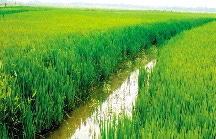
Sharp cutback expected in Mississippi rice acres
After the fourth largest rice acreage in Mississippi history in 2010, plantings are expected to drop significantly this year in response to high prices for other crops. “Last year, we had 305,000 acres,” says Tim Walker, associate research professor at the Delta Research and Extension Center, Stoneville, Miss. “With the ability of growers now to lock in good prices for cotton, corn, and soybeans, I’m looking for only about 214,000 acres of rice this season,” he said at the annual conference of the Mississippi Agricultural Consultants Association at Mississippi State University.

After the fourth largest rice acreage in Mississippi history in 2010, plantings are expected to drop significantly this year in response to high prices for other crops.
“Last year, we had 305,000 acres,” says Tim Walker, associate research professor at the Delta Research and Extension Center, Stoneville, Miss. “Historically, we’ve seen a sizable rice acreage decline in the year following a large crop. Combine that trend with the ability of growers now able to lock in good prices for cotton, corn, and soybeans, and I’m looking for only about 214,000 acres of rice this season,” he said at the annual conference of the Mississippi Agricultural Consultants Association at Mississippi State University.
“I don’t think acres will drop under 200,000, but I don’t expect to see more than 215,000 on the top end.”
The 2010 season got off to “an almost perfect start,” Walker says. “Thanks to good weather, I’ve never seen so much rice go in the ground so fast — we were basically done planting by early May.
But, things went downhill when high temperatures in July and August caused sterility and panicle blight.
“Ten days of 100 degrees-plus daytime and abnormally high nighttime temperatures took a toll,” he says.
“Earlier planted fields had quite good yields, but some of the later-planted rice suffered, with yields of 100 bushels or below.”
Planting date studies that have been under way for several years continue to show the historic “sweet spot” for seeding rice is late March to May, Walker notes.
“We have planted in late May some years and cut good rice — but not last year. Yields from early planted rice were phenomenal, but for rice planted in early May, yields fell considerably, as low as 114 bushels.”
Lodging was also a problem in many fields of Clearfield 151, a variety that has become popular with growers and was planted on a large percentage of acres in 2010, he says.
“This variety has tremendous yield potential — over 200 bushels per acre — but its main weakness is lodging. In many cases, this is related to nitrogen management.
An efficient user of nitrogen
“This variety is a very efficient user of nitrogen, and some growers are just applying too much. Our studies show 90 percent of Clearfield 151’s yield potential can be achieved at just 88 pounds of N, and for most situations 118 to120 pounds is about ideal.”
Nitrogen rate/lodging studies for Clearfield 151 have shown no significant difference in yields for N rates as high as 135 to 180 pounds
“We’ve simply got to get away from the mentality that nitrogen response is linear — that the more N you apply, the more yield you’ll get. In many cases, particularly with a variety like this, growers are over-applying nitrogen.”
Not only does that increase potential for lodging in a variety like 151, Walker says, “with $500 per ton urea, you’re spending money unnecessarily.”
Seeding rate can also have an impact on lodging with Clearfield 151, he notes.
“In our studies, we had less lodging with a seeding rate of about 30 seeds per square foot, or 65 pounds per acre, and about 120 pounds total N. Managing Clearfield 151 with the appropriate combination of seed rate and N rate can be effective in managing lodging. Protecting the seed with effective seed treatment is recommended, especially at the recommended seeding rate.”
Nitrogen stability is also important, Walker says. “There are a lot of nitrogen stabilizer products on the market, but Agrotain is the only one tests have shown to do what it says it will do.
“Because nitrogen is such an important component of rice production and because it is so expensive, growers need to protect that investment. The data show this product works — it offers a proven mechanism for limiting volatilization of nitrogen.”
About the Author(s)
You May Also Like



